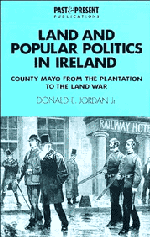Book contents
- Frontmatter
- Contents
- List of figures
- List of maps
- List of tables
- Acknowledgments
- List of abbreviations
- Introduction
- PART 1 COUNTY MAYO PRIOR TO THE FAMINE
- 1 The natural and historical setting
- 2 Economy and society, 1691-1846
- 3 Pre-Famine popular politics and rural protest
- PART 2 THE POST-FAMINE TRANSFORMATION OF COUNTY MAYO
- PART 3 THE LAND WAR IN COUNTY MAYO
- 1 Mayo evictions: explanation of calculations and sources for Table 4.1 and Figure 4.1
- 2 Occupations of suspected Fenians, County Mayo, as recorded in police files, 1866-71
- 3 List of persons whose arrest is recommended under the Protection of Persons and Property Act, 1881, County Mayo
- 4 Explanation of categories and list of Land League meetings for Map 5.2 and Table 3.1
- Bibliography
- Index
- Past and Present Publications
1 - The natural and historical setting
Published online by Cambridge University Press: 03 May 2011
- Frontmatter
- Contents
- List of figures
- List of maps
- List of tables
- Acknowledgments
- List of abbreviations
- Introduction
- PART 1 COUNTY MAYO PRIOR TO THE FAMINE
- 1 The natural and historical setting
- 2 Economy and society, 1691-1846
- 3 Pre-Famine popular politics and rural protest
- PART 2 THE POST-FAMINE TRANSFORMATION OF COUNTY MAYO
- PART 3 THE LAND WAR IN COUNTY MAYO
- 1 Mayo evictions: explanation of calculations and sources for Table 4.1 and Figure 4.1
- 2 Occupations of suspected Fenians, County Mayo, as recorded in police files, 1866-71
- 3 List of persons whose arrest is recommended under the Protection of Persons and Property Act, 1881, County Mayo
- 4 Explanation of categories and list of Land League meetings for Map 5.2 and Table 3.1
- Bibliography
- Index
- Past and Present Publications
Summary
THE NATURAL SETTING
One of the four counties carved out of the kingdom of Connacht by Elizabethan administrators after 1570, Mayo is Ireland's third largest county, containing 2084 square miles arrayed in a complex pattern of land forms. Situated on the western edge of the European land mass, Mayo contains geological structures of great antiquity, especially the mountains along its Atlantic coast that date from the late pre-Cambrian era. The metamorphism of the physical landscape over the next 600 million years resulted in a dramatically uneven topography that has conditioned the patterns of human settlement and interaction in what has been for centuries Ireland's poorest county. The most significant topographic contrast is that between the relatively fertile central region of Mayo and the largely barren areas along the western coast and eastern boundaries of the county. From the time of the earliest inhabitants of the county, the central region of Mayo has been the nucleus of settlement and the avenue through which political, social, and economic changes penetrated Mayo. In contrast, residents of the peripheral regions, hindered by rough terrain, poor quality land, and few passable roads were cut off from contact with the more dynamic parts of the country.
- Type
- Chapter
- Information
- Land and Popular Politics in IrelandCounty Mayo from the Plantation to the Land War, pp. 13 - 36Publisher: Cambridge University PressPrint publication year: 1994

